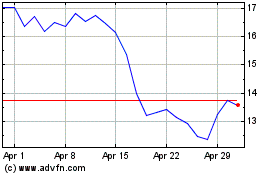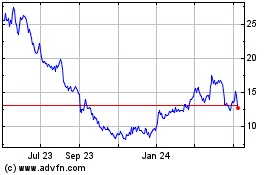- 95 percent of patients infected with
genotype 3 (GT3) chronic hepatitis C virus (HCV), without cirrhosis
and who are new to treatment achieved SVR12 with 8 weeks of
treatment
- Together with previously reported data,
these study results support the potential of G/P as an 8-week
treatment for the majority of people living with HCV across all
genotypes
- GT3 is the second most common genotype
worldwide and the most challenging to treat2,3; limited treatment
options exist for newly diagnosed patients
- Glecaprevir is Enanta’s second protease
inhibitor being developed through its collaboration with AbbVie and
is one of the two new direct-acting antivirals (DAAs) in G/P
Enanta Pharmaceuticals, Inc. (NASDAQ:ENTA), a research and
development-focused biotechnology company dedicated to creating
small molecule drugs for viral infections and liver diseases, today
reported that AbbVie announced high SVR rates were achieved with 8
weeks of treatment with its investigational, once daily,
ribavirin-free, pan-genotypic regimen of glecaprevir/pibrentasvir
(G/P) in patients with challenging-to-treat genotype 3 (GT3)
chronic hepatitis C virus (HCV) infection. In results from AbbVie’s
Phase 3 ENDURANCE-3 study, 95 percent (n=149/157) of GT3 chronic
HCV-infected patients without cirrhosis and who were new to
treatment achieved sustained virologic response at 12 weeks
post-treatment (SVR12) following 8 weeks of treatment with G/P.1
These results will be featured as an oral presentation today at The
International Liver Congress™ (ILC) 2017 in Amsterdam, The
Netherlands.
In addition to evaluating 8 weeks of treatment with G/P, the
ENDURANCE-3 study was designed to evaluate whether 12 weeks of G/P
treatment is non-inferior to 12 weeks of sofosbuvir plus
daclatasvir (SOF+DCV), a current standard of care for GT3 chronic
HCV-infected patients.1 SVR12 rates of 95 percent were seen in both
8 weeks (n=149/157) and 12 weeks (n=222/233) of treatment with
G/P.1 Additionally, 12 weeks of treatment with G/P was demonstrated
to be non-inferior to 12 weeks of treatment with SOF+DCV (97
percent, n=111/115).1
GT3 is the second most common genotype globally, accounting for
18 percent of patients worldwide and 26 percent of patients in
Europe.2 Patients with GT3 HCV have more rapid disease progression,
with the highest rates of associated fibrosis, steatosis (fatty
liver), and hepatocellular carcinoma (HCC).3 Treatment guidelines
with current standards of care recommend 12 weeks of treatment in
GT3 patients without cirrhosis and who are new to treatment.4
Full results from ENDURANCE-3 are the latest to be released from
AbbVie’s registrational studies in its G/P clinical development
program, designed to investigate a faster path to virologic cure*
for all major HCV genotypes (GT1-6) and with the goal of addressing
areas of continued unmet need.
In the ENDURANCE-3 study, no patients who received 8 weeks of
G/P discontinued treatment due to adverse events (AEs).1 AEs were
mostly mild (71 percent) in patients receiving both 8 and 12 weeks
of G/P. The most common AEs (≥10 percent) in patients receiving 8
weeks and 12 weeks of G/P were headache (20 and 26 percent),
fatigue (13 and 19 percent) and nausea (12 and 14 percent),
respectively and with patients receiving 12 weeks of SOF+DCV
treatment (headache 20 percent, fatigue 14 percent and nausea 13
percent).1
Authorization applications for G/P are currently under review by
regulatory authorities around the world. G/P has been granted
accelerated assessment by the European Medicines Agency, and
priority review designations by the U.S. Food and Drug
Administration and Japanese Ministry of Health, Labour and Welfare.
G/P is an investigational regimen and its safety and efficacy have
not been established.
The ENDURANCE-3 study will be featured in the official ILC press
conference on Friday, April 21 from 11:30 a.m. - 12:30 p.m. local
time.
About the ENDURANCE-3 StudyENDURANCE-3 is a Phase 3,
open-label, active-controlled study evaluating patients who are new
to treatment with HCV GT3 infection without cirrhosis. The study
included 505 patients who were randomized to receive either 12
weeks of G/P (Arm A, n= 233) or 12 weeks of SOF+DCV (Arm B, n=115),
with subsequently enrolled patients receiving 8 weeks of G/P (Arm
C, n=157). The primary endpoint was the percentage of patients
achieving SVR12. The rate of virologic failure was 1.7 percent
(n=4/233) in Arm A, 0.8 percent (n=1/115) in Arm B and 3.8 percent
(n=6/157) in Arm C.
Additional information on the clinical trials for G/P is
available at www.clinicaltrials.gov.
About G/PG/P is an investigational, pan-genotypic regimen
that is being evaluated by AbbVie as a potential cure in 8 weeks
for HCV patients without cirrhosis and who are new to treatment
with direct-acting antivirals (DAAs)**, who make up the majority of
HCV patients. AbbVie is also studying G/P in patients with specific
treatment challenges, such as patients with genotype 3 HCV,
patients who were not cured with previous DAA treatment and those
with chronic kidney disease, including patients on dialysis.
G/P is an investigational, once-daily regimen that combines two
distinct antiviral agents in a fixed-dose combination of
glecaprevir (300mg), an NS3/4A protease inhibitor, and pibrentasvir
(120mg), an NS5A inhibitor. G/P is dosed once-daily as three oral
tablets.
*Patients who achieve a sustained virologic response at 12 weeks
post treatment (SVR12) are considered cured of hepatitis C.
**Patients who are treatment-naive or had prior treatment
experience with IFN-based treatments ([peg]IFN +/- RBV or SOF/RBV
+/- pegIFN).
About EnantaEnanta Pharmaceuticals is a research and
development-focused biotechnology company that uses its robust
chemistry-driven approach and drug discovery capabilities to create
small molecule drugs for viral infections and liver diseases.
Enanta’s research and development efforts are currently focused on
the following disease targets: non-alcoholic steatohepatitis
(NASH)/ primary biliary cholangitis (PBC), respiratory syncytial
virus (RSV) and hepatitis B virus (HBV).
Enanta has discovered novel protease inhibitors for use against
the hepatitis C virus (HCV). These protease inhibitors, developed
through Enanta’s collaboration with AbbVie, include paritaprevir,
part of AbbVie’s currently marketed HCV regimens, and glecaprevir
(ABT-493), Enanta’s second protease inhibitor product, which AbbVie
is developing as part of its investigational, pan-genotypic HCV
regimen of glecaprevir/pibrentasvir (G/P) now in registration in
the U.S., the E.U. and Japan. Royalties and any further milestone
payments from this collaboration will provide additional funding
for Enanta’s earlier development programs, including its Phase 1
FXR agonist program for NASH/PBC, and its preclinical programs for
HBV and RSV. Please visit www.enanta.com for more information on
Enanta’s programs and pipeline.
Forward Looking StatementsThis press release contains
forward-looking statements, including statements with respect to
the prospects for AbbVie’s G/P regimen for HCV. Statements that are
not historical facts are based on management’s current
expectations, estimates, forecasts and projections about Enanta’s
business and the industry in which it operates and management’s
beliefs and assumptions. The statements contained in this release
are not guarantees of future performance and involve certain risks,
uncertainties and assumptions, which are difficult to predict.
Therefore, actual outcomes and results may differ materially from
what is expressed in such forward-looking statements. Important
factors and risks that may affect actual results include: the
efforts of AbbVie (our collaborator developing glecaprevir) to
obtain regulatory approvals of its glecaprevir/pibrentasvir (G/P)
combination and commercialize it successfully; the regulatory and
marketing efforts of others with respect to competitive treatment
regimens for HCV; regulatory and reimbursement actions affecting
G/P, any competitive regimen, or both; the need to obtain and
maintain patent protection for glecaprevir and avoid potential
infringement of the intellectual property rights of others; and
other risk factors described or referred to in “Risk Factors” in
Enanta’s most recent Form 10-K for the fiscal year ended September
30, 2016 and other periodic reports filed more recently with the
Securities and Exchange Commission. Enanta cautions investors not
to place undue reliance on the forward-looking statements contained
in this release. These statements speak only as of the date of this
release, and Enanta undertakes no obligation to update or revise
these statements, except as may be required by law.
__________________________________________
1 Foster, GR et al. ENDURANCE-3: safety and efficacy of
glecaprevir/pibrentasvir compared to sofosbuvir plus daclatasvir in
treatment-naïve HCV genotype 3-infected patients without cirrhosis.
Presented at The International Liver Congress™ (ILC) in Amsterdam,
The Netherlands, April 19-23, 2017.
2 Petruzziello, A. et al. Global epidemiology of hepatitis C
virus infection: An up-date of the distribution and circulation of
hepatitis C virus genotypes. World J Gastroenterol. 2016; 22(34):
7824-7840
3 Asselah T, Thompson AJ, Flisiak R, Romero-Gomez M, Messinger
D, Bakalos G, et al. (2016) A Predictive Model for Selecting
Patients with HCV Genotype 3 Chronic Infection with a High
Probability of Sustained Virological Response to Peginterferon
Alfa-2a/Ribavirin. PLoS ONE 11(3): e0150569.
doi:10.1371/journal.pone.
4 EASL Recommendations on Treatment of Hepatitis C 2016. J
Hepatol (2016), http://dx.doi.org/10.1016/j.jhep.2016.09.001.
View source
version on businesswire.com: http://www.businesswire.com/news/home/20170421005254/en/
Investor ContactEnanta Pharmaceuticals, Inc.Carol Miceli,
617-607-0710cmiceli@enanta.comorMedia ContactMacDougall
Biomedical CommunicationsKari Watson,
781-235-3060kwatson@macbiocom.com
Enanta Pharmaceuticals (NASDAQ:ENTA)
Historical Stock Chart
From Mar 2024 to Apr 2024

Enanta Pharmaceuticals (NASDAQ:ENTA)
Historical Stock Chart
From Apr 2023 to Apr 2024
